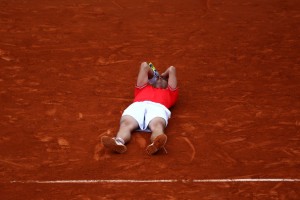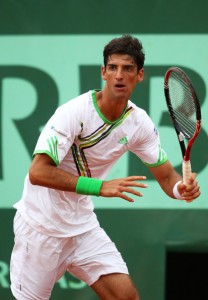French Open, Day Six
(13) Gasquet d. (23) Bellucci, 6/2 6/3 3/6 6/3
The stylistic cliches that define tennis coverage are legion, and cover the entire spectrum of suck, from bowel-wrenching cringeworthiness to the extravagantly pointless. Examples of the former include those horrible interviews with players directly before they step on court, or Barbara Schett interviewing anybody. An example of the latter would be Spidercam, which subsists  almost entirely on the belief that everything is more thrilling when the camera is moving. Fortunately, no one has cottoned on that the action is even more intense when the camera is handheld. Think of The Bourne Supremacy, and now imagine the Wimbledon final as directed by Paul Greengrass. Praise be for small mercies.
almost entirely on the belief that everything is more thrilling when the camera is moving. Fortunately, no one has cottoned on that the action is even more intense when the camera is handheld. Think of The Bourne Supremacy, and now imagine the Wimbledon final as directed by Paul Greengrass. Praise be for small mercies.
The technology for cable-suspended camera systems has been around since the 1980s, although it took almost 20 years to gain currency with broadcasters, who arrived only gradually at the realisation that many sports are too visually dull to engage viewers without adequate technical gimmicks. By the early part of last decade, Skycam was seeing use at a number of NFL and NCAA fixtures. It was roughly concurrent to this that the concept made the digitised crossover to motion pictures. Recall the Battle of Dagorlad in the prologue to The Fellowship of the Ring, where it perfectly complimented the sweep of a vast battle, or in Troy, where it helped make some very boring sequences more confusing. That swooping panoramic shot is now standard for any battle sequences in any film, a visual shorthand for ‘epic’, which once upon a time meant something other than endless combatants – real or virtual – or the supplementary biceps on Brad Pitt’s jaw.
The irony is that, despite those Skycam-type shots being borrowed from sports coverage in order to lend movie sequences a heightened dynamism, sports have since re-appropriated the technology in order to invest events with an epic quality.
However, tennis coverage has to be more than just epic. Unlike the battle sequences in Troy, it has to make sense. Viewers really need to be able to follow what’s going on, and as the athletes are moving quite a lot during the course of play, this makes a stationary viewpoint strictly necessary.  In any case, Spidercam cannot be deployed during points, since anything larger than a stray gnat cripples a player’s concentration. Consequently, Spidercam’s task is almost entirely limited to swooping down onto the court while a player collects balls, or in the 78 seconds between Djokovic beginning his service preparation and the point actually commencing. Epic it is not, but still they try.
In any case, Spidercam cannot be deployed during points, since anything larger than a stray gnat cripples a player’s concentration. Consequently, Spidercam’s task is almost entirely limited to swooping down onto the court while a player collects balls, or in the 78 seconds between Djokovic beginning his service preparation and the point actually commencing. Epic it is not, but still they try.
Thus did I muse today as the camera swung in low and fast over the heads of a thousand screeching Parisians, wheeling lazily over the scruffy, slope-shouldered, red-clad hobo gathering balls at one end of the court. Match point had finally arrived, courtesy of a screaming forehand winner. He served, and match point was won, and Richard Gasquet was on his back, another sure clue that the match had been truly epic. The crowd were losing it, and Tomaz Bellucci, with his unruffled tan and vast sensitive eyes, was striding netwards. The scene vaguely recalled Federer’s 2009 Roland Garros triumph, in exultation if not in detail, the key differences being that this was a third round match, and although it had been closer than the scoreline indicated, it hadn’t been much closer. It boasted all the furnishings of an epic, except where it mattered.
Nevertheless, it is the first time Gasquet has progressed to the last 16 at his home Slam, which explains why he hit the dirt so suddenly. Whether he goes any further is a dicey question. Next up as faces the winner of Novak Djokovic and Juan Martin del Potro, a third rounder for the ages. Locked at a set each, play was suspended until tomorrow. Expect an epic.
